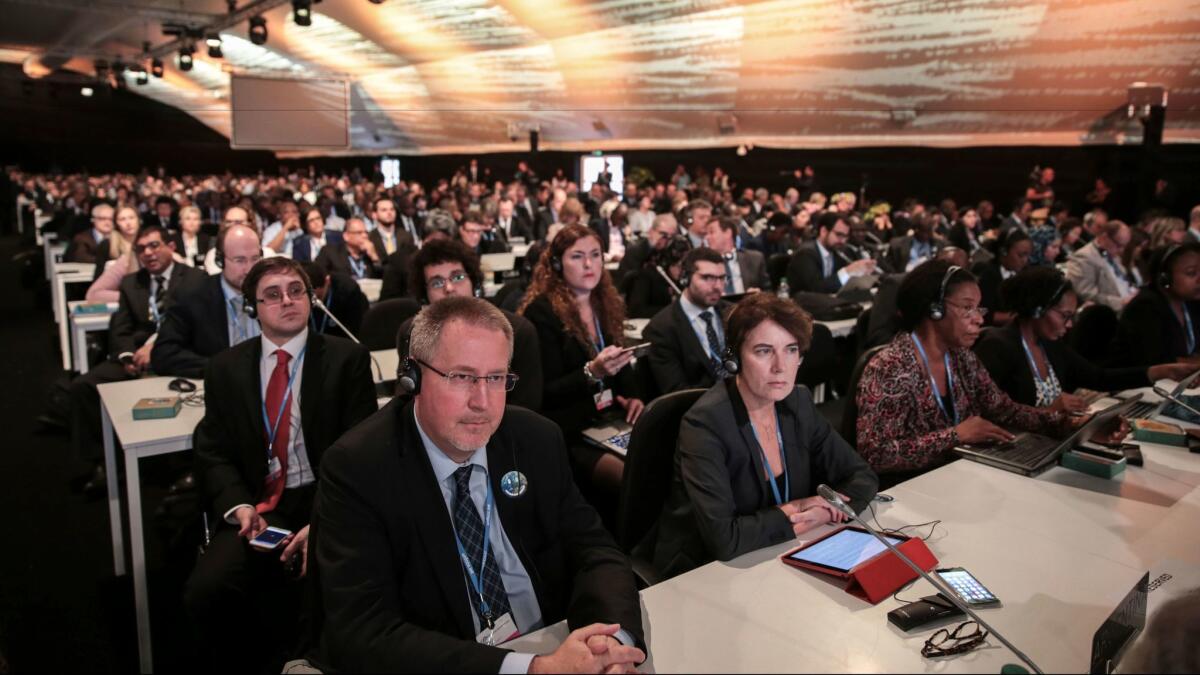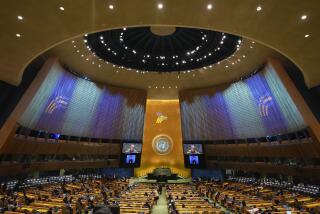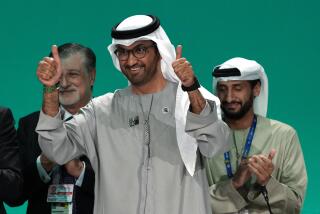The Paris climate deal just became law. Now countries must figure out how to make good on their pledges

Reporting from Marrakech, Morocco — The landmark climate accord reached in Paris in December was ratified with uncommon speed, entering into force last week after it was approved by countries accounting for nearly two-thirds of planet-warming emissions.
But world leaders acknowledge that much remains to be fleshed out if countries are to achieve the stated goal of limiting global temperature increases to “well below” 2 degrees Celsius above pre-industrial levels, and as close to 1.5 degrees Celsius as possible.
Negotiators hope to make a start at an 11-day conference that opened Monday in the Moroccan city of Marrakech.
The blistering pace at which the accord became international law underscores the urgency of the task at hand, U.N. climate chief Patricia Espinosa said in opening remarks.
“Achieving the aims and ambitions of the Paris agreement is not a given,” she warned. “We have embarked on an effort to change the course of two centuries of carbon-intense development. The peaking of global emissions is urgent, as is attaining far more climate-resilient societies.”
Morocco’s foreign minister, Salaheddine Mezouar, who is leading the talks, said the next two weeks should “give tangible meaning to the ideas and proposals” contained in the accord.
The stakes are high: Last year was the hottest on record, and 2016 is on track to eclipse it. Countries are already feeling the effects of rising sea levels, prolonged drought and extreme storms and flooding.
Many people are suffering daily and “wondering about their future, even their very existence,” Mezouar said. “It is therefore up to all of us to be up to this global challenge and not disappoint the expectations of vulnerable populations.”
Casting doubt over the talks is a contentious U.S. election that has raised questions about the commitment of one of the world’s biggest polluters to the agreement.
The Obama administration played a key role in bringing more than 20 years of difficult climate negotiations to a successful conclusion in Paris and has pledged to reduce U.S. greenhouse gas emissions by 26% to 28% below 2005 levels by 2025.
Hillary Clinton, the Democratic presidential nominee, supports Obama’s climate goals. But there is concern among world leaders that the U.S. could ignore its commitments under the deal, or pull out entirely, if Donald Trump becomes president.
The Republican candidate has repeatedly questioned climate science and said he would “cancel” the agreement if elected.
That is one of the reasons countries were in such a hurry to complete the approval process. Once the deal took effect Friday, the rules require at least four years to pass before the U.S. could withdraw.
U.S. climate envoy Jonathan Pershing told reporters last week that he didn’t think such a move was likely, in part because of the investment opportunities in renewable energy.
“My sense,” he said, “is that there are going to be huge domestic advantages to staying in this agreement and to doing the work that we’ve agreed to do.”
The accord relies on countries to set their own targets to slash emissions of carbon dioxide and other greenhouse gasses that scientists say are the major cause of global warming.
Even if implemented in full, the emission reductions currently on the table won’t be sufficient to hold temperatures to an increase of less than 2 degrees Celsius, or 3.6 degrees Fahrenheit, the threshold at which scientists believe many of the most damaging effects of climate change can be averted.
An analysis released last week by the United Nations Environment Program found that the world is on course to warm by 2.9 degrees Celsius to 3.4 degrees Celsius this century.
That’s why the deal calls on countries to review progress every five years and ratchet up their commitments. But like many aspects of the deal, the details were left vague. It does not specify, for example, how parties should measure and report on their emissions.
In Marrakech, delegates will begin work on a “rule book” that Espinosa has said should be completed by 2018 to ensure “that everyone is involved in the effort and is delivering to the best of their abilities.”
Only countries that have ratified the agreement can vote on the rules, and the deal’s proponents are hoping this will spur more of the nearly 200 signatories to do so. Just over half have ratified so far.
Other issues that need to be ironed out include how the world’s economies will phase out the use of coal, oil and other fossil fuels that provide the bulk of their energy needs, and how to scale up financing to help poor countries make the shift to cleaner energy sources and cope with the effects of climate change.
Wealthy nations have pledged to mobilize no less than $100 billion a year by 2020 in so-called climate finance. But much of the money is expected to be in the form of loans or to come from the private sector, said Joe Thwaites, a finance expert at the World Resources Institute, a Washington think tank.
This does not sit well with developing nations, which have long argued that the countries that got rich using fossil fuels should shoulder the burden themselves.
Few expect such contentious issues to be resolved in Marrakech. But environmental activists are pressing delegates to agree on a work plan to work out details of the agreement in two years.
“We think that that is both ambitious and realistic,” said Mariana Panuncio-Feldman, senior director of international climate cooperation at the World Wildlife Fund.
Many activists see reason to be optimistic, given how quickly countries ratified the deal. Most international agreements take years to become law.
In order to achieve Friday’s milestone, at least 55 nations that collectively account for 55% of global emissions had to approve the Paris accord. That threshold was reached in early October.
By Monday, the number had increased to 100, including the world’s top polluters, China, the United States, the European Union and India.
Climate negotiators scored another success when an agreement was reached in Kigali, Rwanda, in October to phase out the use of chemical coolants called hydrofluorocarbons, or HFCs. Used in air-conditioners and refrigerators, HFCs are far more potent than carbon dioxide and are also the world’s fastest-growing greenhouse gases, according to the U.N.
That same month, delegates at the International Civil Aviation Organization, a U.N. agency headquartered in Montreal, reached agreement on a plan to reduce the growing impact of plane travel on the climate.
“We must capitalize on this momentum,” Mezouar told delegates Monday.
“I would like to invite you over the coming 11 days to be more ambitious than ever in your commitments. All over the world, public opinion must perceive change.”
Times staff writer Zavis reported from Los Angeles and special correspondent Sampathkumar from Marrakech.
Twitter: @alexzavis
More to Read
Sign up for Essential California
The most important California stories and recommendations in your inbox every morning.
You may occasionally receive promotional content from the Los Angeles Times.











